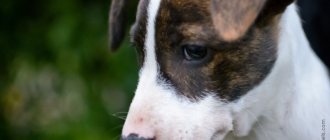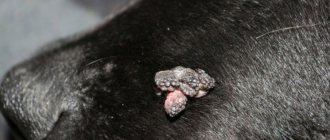Parvovirus (hemorrhagic) enteritis of dogs , Parvovirus enteritis canine, is an acute, highly contagious viral disease of dogs caused by a pathogen of the parvovirus genus, accompanied by vomiting, hemorrhagic inflammation of the gastrointestinal tract, myocarditis, leukopenia, dehydration and death of puppies under 5 months of age.
The disease was first identified in the USA (Appel et al., 1978). Currently, it is one of the most common infectious diseases in dogs. The concept has been put forward that parvovirus enteritis becomes widespread when the dog population density is 12 or more per 1 km². When the density decreases to 6 or less individuals, the infection practically stops.
The causative agent is Canine parvovirus, a DNA virus of the Parvoviridae family, antigenically related to the feline panleukopenia and mink enteritis viruses. Canine animals are susceptible to the virus, with young animals aged 2-12 months being the most sensitive. Diseases have been observed in the maned wolf, raccoon, raccoon dog, corsac dog, and coyote.
Epizootological data . The source of infection are sick dogs, dogs - virus carriers, which release the virus in large quantities into the external environment with feces within 10 days after the onset of the disease (perhaps urine and saliva also play a role in the spread of the virus), as well as rodents, insects and humans. Under natural conditions, the disease is observed in dogs of all ages, but more often in puppies under 6 months of age; parvovirus enteritis has been detected in martens and raccoon dogs. Infection of healthy dogs occurs mainly through contaminated food and water, as well as through contact - as a result of sniffing and licking directly sick animals or environmental objects infected by them. Additionally, dogs can become infected through virus-infected grooming items and bedding. In the occurrence of parvovirus enteritis in dogs, a decrease in the resistance of the dog’s body caused by: poor care, violations of housing and feeding conditions, helminthic infestation, diseases of the gastrointestinal tract, stressful situations (change of owner, surgery) is of great importance. In 2-15 week old martens and raccoon dogs, the disease appears more often and the mortality rate reaches 30%. The virus is highly resistant to heat (stable when heated at 60°C for an hour), pH 3, disinfectants, and environmental factors. The virus is resistant to ether, chloform, alcohol and sensitive to sodium hypochlorite and soda.
Pathogenesis . The virus usually enters the dog's body through the mouth and nose. Once in the body, the virus multiplies in the intestinal epithelial cells of the crypts, causing their lysis. Pathogenesis manifests itself based on the physiological state of the dog. As a rule, myocarditis in puppies occurs at 4 weeks of age, when intensive division of myocardial cells is observed, and the division of cells in the intestinal tract is slow during this period. After puppies are weaned, the division of intestinal epithelial cells increases rapidly, while the division of heart muscle cells slows down. Therefore, at this age, the intestines are more often affected in puppies than the myocardium. Characteristic of parvovirus enteritis is leukopenia, which begins to be observed in the first 4-5 days after the onset of the disease. The number of leukocytes decreases significantly and reaches 300-2500 per 1mm³. In this case, leukopenia is often accompanied by a rise in body temperature. On the 4-5th day of illness, antibodies appear and the concentration of the virus in the feces decreases. Antibody formation has a significant impact on viremia. Histological examination reveals desquamation of epithelial cells of the jejunum and ileum, villous atrophy and expansion of the crypts. In the hyperplastic epithelium of the crypts, a high mycotic index is noted. Destroyed lymphoid cells are found in the lymph nodes, thymus and spleen.
Clinical signs . The incubation period for canine parvovirus enteritis is usually 4 to 10 days. A sick dog begins to release the virus into the external environment already 3-5 days after infection; the release of the virus from the body of a sick dog occurs in approximately 12 days, rarely - 25 days. Parvovirus enteritis in dogs manifests itself in 3 forms: intestinal, cardiac and mixed , which usually occur lightly or acutely.
With the lightning-fast course of the intestinal form, the death of puppies at the age of 6-10 weeks occurs a few hours after loss of strength, usually without signs of enteritis. Mortality in this form is very high and without treatment reaches 40-60% in affected puppies. The acute intestinal form develops within 5-6 days, the incubation period lasts up to 6 days.
Often the first sign of the disease is anorexia, followed by mucous vomiting and diarrhea appears 6-24 hours after the start of vomiting. The feces are gray or yellowish-gray at first, then turn green or bright purple, often contain streaks of blood, and are sometimes hemorrhagic with mucus or watery with a strong foul odor. Body temperature rises to 39.5°C, sometimes to 40-41°C. Vomiting (vomiting in dogs) and diarrhea (diarrhea in dogs) quickly lead to dehydration of the dog's body, then a state of shock sets in. Animals, especially young ones, may die 24-96 hours after the appearance of clinical signs of the disease. Leukopenia is not a constant sign; it is observed only in 20-30% of sick animals.
The cardiac form of the disease occurs less frequently in dogs, most often in puppies from 1 to 2 (sometimes 7) months, more often after severe enteritis and is characterized by acute damage to the myocardium (viral myocarditis). In sick animals, we observe heart failure with a rapid and weak pulse and pulmonary edema. Animals suddenly die due to disruption of nerve conduction in the heart muscle. The mortality rate for this form of the disease in dogs reaches 70-80%, with the intestinal form in puppies - up to 50%, in adult dogs - up to 5-10%.
The mixed (combined) form of the disease is characterized by various lesions of the cardiovascular, digestive and respiratory systems of the body. This form is observed in dogs with a weakened immune system, in puppies obtained from unvaccinated bitches, as well as in the presence of associated infections (adeno-, corona-, rotavirus, etc.) in a sick dog. However, the clinical signs of the disease can be very diverse.
When a dog's immunity and natural resistance of the body decrease, parvovirus enteritis is complicated by secondary bacterial diseases and helminthic infestations in the gastrointestinal tract.
Pathological and morphological changes in the intestinal form are characterized by damage to the mucous membrane of the small and large intestines. The mucous membrane is hemorrhagically inflamed. Sometimes erosions are observed on the mucous membrane. The internal organs are hemorrhagic; in some cases, vascular inflammation is noted. The spleen is enlarged and has light areas. Mesenteric lymph nodes are swollen and enlarged. The thymus may be swollen. In some animals, mainly the proximal part of the colon is affected, pulmonary edema and myocarditis are observed.
In microscopic (histological) studies, lesions in the intestine are characterized by necrosis of the crypt epithelium and lymphoid tissue in Peyer's patches, lymph nodes, and thymus. Sometimes intranuclear inclusions are found in epithelial cells. In the cardiac form, dilatation of the valves, pulmonary edema, signs of acute hepatitis and oscitis are observed.
Diagnosis . A presumptive diagnosis of parvovirus enteritis is made based on an analysis of epizootic, clinical data, pathomorphological changes and the results of laboratory (serological and histological) studies. Histological studies reveal characteristic atrophy of the intestinal epithelial villi. To detect the virus in dog feces, RGA is used, followed by its identification in RTGA or passage in a kitten kidney cell culture. Serological diagnosis is based on the study of paired dog blood sera in the RTGA.
Differential diagnosis . Parvovirus enteritis should be differentiated from alimentary and parasitic gastroenteritis (gastroenteritis in dogs), as well as gastroenteritis of viral etiology, noted with distemper and enteritis caused by coronovirus, as well as with viral hepatitis of carnivores.
Immunity and means of specific prevention . Dogs that have naturally recovered from the disease develop a strong immunity that lasts at least 3 years. There are some reports that it is a life sentence. After artificial immunization of dogs with inactivated vaccines, the duration of immunity does not exceed 6 months, and after vaccination with live virus vaccines - a year. For specific prevention, inactivated and live culture vaccines are used against panleukopenia in cats and parvovirus enteritis in dogs (pentodog, hexodog and others). Vaccination of dogs against parvovirus enteritis is carried out at the age of 2 months to a year twice with an interval of 2-3 weeks, after a year once.
Before vaccinating their dog, animal owners must undergo mandatory deworming. This is due to the fact that any helminthic infestation reduces the animal’s immune status, resulting in the risk of such a phenomenon as “vaccine breakthrough”, when, despite the vaccination, the dog may become ill with parvovirus enteritis. The most popular anthelmintics are: Cestal, SEVA Sante Animal; Drontal and Drontal Junior, Bayer and others.
Treatment.
Veterinary specialists at clinics when treating parvovirus enteritis in dogs usually adhere to a specific treatment regimen, which includes:
- destruction or neutralization of enteric viruses;
- removing a dog from a state of dehydration;
- cessation of vomiting and diarrhea;
- conducting detoxification therapy;
- stimulation of immunity;
- restoration of normal functioning of the gastrointestinal tract;
- restoration of normal functioning of the cardiovascular system.
The main goal of treatment for a disease is to most effectively support the functioning of all organs and systems of the body until the animal’s own immune forces begin to fight the disease (by 5-6 days, when the production of its own antibodies to fight viruses begins). Considering that the dog’s disease develops very rapidly from the treatment, literally within a day from the start of treatment, the animal will either feel better (there is hope for recovery), or the sick dog will die (when the treatment was not effective). But it always makes sense for its owner to fight for the life of a pet!
Pathogen and its features
The causative agent of canine parvovirus enteritis is one of the smallest DNA-containing viruses, with a fairly simple structure and is characterized by the absence of an envelope. It belongs to the Parvovirus family, to which it also belongs, causing panleukopenia in cats and enteritis in minks. There are two types of this virus: type 1 is not dangerous and is often found in the feces of clinically healthy dogs, and type 2 is highly destructive and causes clinical signs of enteritis.
The virus is quite resistant to environmental factors, acidity and temperature changes. Survives in the external environment at 80 ° C - 15 minutes; at 60 C - 1 hour; at 56 °C - 24 hours; at 37 °C - 2 weeks; at 20 °C - 3 months; at 4 °C - more than six months. It can remain viable in dried feces for more than a year, and also survives at low temperatures. The virus is resistant to most disinfectants. However, it is destroyed by a 0.5% formaldehyde solution and a 4% chloramine solution.
Epizootology
Canines are susceptible to parvovirus, with young animals aged 2-12 months being the most sensitive. The main source of the virus is sick animals and virus carriers, from which it is excreted in large quantities in feces within 10 days after the onset of the disease. It is possible that urine and saliva also play a role in the spread of the virus.
Rottweilers and toy breeds such as poodles and lapdogs are genetically susceptible to this disease.
The source of infection can be sick dogs, virus-carrying dogs, rodents, insects, as well as humans. The virus can also be transmitted through care items and bedding.
For the occurrence of parvovirus enteritis in dogs, the presence of predisposing factors is of great importance: poor care, maintenance and feeding, stressful situations - change of owner, surgery, helminthic infestation, and a tendency to gastrointestinal disorders.
Routes of infection
The feces of sick dogs are the main source of spread of the pathogen. The virus can also be in vomit with mucus. Because the virus can persist in the environment for a long time, it can pose a threat to unvaccinated animals. Dogs that have had parvovirus enteritis can be carriers of the infection for a long time. The pathogen is transmitted through contact of sick dogs with healthy ones, as well as through animal care items contaminated with the virus (scrapers, combs), feed, and soil contaminated with secretions of infected animals. People can also transmit the virus through clothing and shoes. The virus enters the body of a healthy animal either through the oral cavity or through the respiratory tract when sniffing the source. Development of the disease (pathogenesis).
The virus enters the body most often through the digestive tract, nasal mucosa, and lymphoid cells of the pharynx. The pathogenesis of the disease largely depends on the age of the dog. The virus multiplies in actively dividing cardiac muscle cells and in the intestinal mucosa. In newborn puppies, heart cells multiply quite quickly during the first 2 to 4 weeks of life, while the formation of intestinal mucosal cells occurs later. After puppies stop suckling their mother's milk, intestinal cells divide more intensively, and myocardial cells multiply more slowly, so during this period, puppies that are not protected by maternal antibodies from colostrum are more often affected by the intestines rather than the heart muscle. The disease occurs in two forms - intestinal, which occurs much more often in puppies from 8 weeks of age and sometimes in adult dogs. And cardiac, which occurs in the offspring of an unvaccinated mother during the suckling period.
After entering the animal’s body, the pathogen naturally multiplies in the pharyngeal lymph nodes - white blood cells, then enters the blood and spreads throughout the body. Lymphoid tissue in dogs is characterized by a high rate of division, and therefore the virus usually affects lymph nodes, lymphoid tissues, and villi of the intestinal mucosa.
Characteristics of parvovirus
The exact origin of canine parvovirus is unknown; it is believed to have arisen from feline panleukopenia virus (not scientifically proven). It is a non-enveloped, single-stranded DNA virus that is resistant to many common disinfectants and a wide range of temperatures and pH. The infectious virus can survive indoors at room temperature for two months. Outdoors, as long as it is kept out of direct sunlight and kept dry, it can survive for many months and possibly years.
Today, veterinary virology distinguishes two types of parvovirus that can infect dogs:
- Parvovirus type 1 is CPV1.
- Parvovirus type 2 is CPV2.
It is CPV2 that causes the most serious course of the disease and affects not only domestic dogs, but also wild canines. In turn, parvovirus enteritis of the second type may consist of the following types of virus:
- The classic parvovirus type 2 is CPV-2.
- CPV-2a.
- CPV-2b.
- CPV-2c.
Antigenic models 2a and 2b are quite similar to each other and to classical CPV-2. Option 2c has a unique antigenic pattern, which allows it to be distinguished from other types, but the manifestation of the disease is the same in any case. However, differences in the structural pattern of the 2c variant of parvovirus raise suspicions that vaccination in dogs is ineffective. This was thought for some time until studies showed that existing vaccines based on parvovirus type 2b provided an adequate level of protection against parvovirus 2c.
Which dogs are more likely to become infected with parvovirus enteritis?
Puppies aged from 6 weeks to 6 months that have not been vaccinated at all, or the vaccination process was carried out in violation of the regulations, are more susceptible to canine parvovirus infection. Vaccination of the mother at an early age is important for puppies.
When it comes to dog breeds, those most at risk of contracting parvovirus are:
- Rottweilers.
- Dobermans.
- American Pit Bull Terriers.
- English Springer Spaniels.
- German Shepherds.
- Labrador retrievers.
- American Staffordshire Terriers.
In addition, most members of the canine family - wolves, foxes and other animals - are infected and transmitted.
By receiving a sufficient amount of mother's milk, puppies born from a timely vaccinated mother are protected from infection during the first few weeks of life. However, susceptibility to infection gradually increases as the resistance of maternal antibodies obtained in milk weakens. In addition, enteritis in puppies often develops due to weakened immunity due to stressful events, for example, due to weaning, a large number of brothers and sisters in the litter, malnutrition and other factors.
As a rule, in such puppies, enteritis is aggravated by simultaneous intestinal diseases or pathogenic infection. This list of diseases often includes clostridiosis, campylobacteriosis, salmonellosis, giardiasis and coronavirus infection. All these diseases are characterized by a more severe clinical manifestation of parvovirus infection.
As for adult animals, among dogs older than 6 months of age, males are more often affected. In dogs older than 7 years of age, parvovirus actively develops due to weakened immunity with age.
Clinical signs
Parvovirus enteritis has quite a variety of symptoms, which can appear in various combinations and make it difficult to determine the disease. It is typical that in adult dogs the disease occurs in a latent form without clear clinical manifestations, and in puppies in acute and fulminant forms and leads to rapid death. There are a number of signs, the combination of which indicates the development of this disease.
The incubation period of the disease is 2-3 days, after which the following is observed:
- Lethargy
- the dog becomes less active, tries to make fewer movements and hides. The dog may not react to the actions taking place around him and rarely gets up. - Refusal to feed
– the animal suddenly loses its appetite and stops drinking water. - An increase in body temperature
- up to 39°C and above, fever develops, which signals the infectious nature of the disease. However, sometimes with enteritis the temperature may rise just before the pet dies, so you should pay attention to other signs of the disease. - Pain syndrome
- the animal begins to arch its back when stroking, and when touching the stomach area it tries to move away, movements are constrained - this is the first manifestation of the disease. - Vomiting
occurs within a day after the incubation period. Initially, vomit consists of the remains of undigested food, later it becomes grayish mucus. - Diarrhea
- liquid stool, initially yellowish or greenish in color, later red, may contain blood clots, and also has a foul odor. - Dehydration
- the body loses fluid quite quickly, and as a result, the disease can be fatal in 2-3 days.
Consequences of enteritis in dogs
Puppies that survive parvovirus enteritis show the consequences of the growth of fibrous tissue in the myocardium, which is essentially an acquired heart defect that affects the entire future life of the dog.
It is important to understand that an animal that survives parvovirus enteritis in any form will still shed remnants of the virus in its feces for at least 10 days, up to an average of three weeks. Among other things, a dog can become a carrier of parvovirus and from time to time, in the course of its life, release it into the external environment and infect other animals.
Symptoms of parvovirus infection in dogs
Symptoms of parvovirus enteritis in dogs without treatment usually develop within 5-7 days after infection, but this period can range from 2 to 14 days. Initial clinical signs may be nonspecific, such as apathy, lack of appetite, fever, with progression to vomiting and hemorrhagic diarrhea over the next 24-48 hours.
Physical examination findings may include:
- loss of motor activity;
- fever;
- dehydration;
- dilated intestinal loops on ultrasound or x-ray, filled with fluid.
The animal's response to abdominal pain requires further evaluation to rule out the potential complication of intestinal obstruction.
In the most severe cases, non-specific symptoms of parvovirus in dogs may include:
- short-term loss of consciousness;
- pallor of the mucous membranes;
- low pulse quality;
- tachycardia;
- reduced body temperature.
The lack of treatment is due to symptoms of enteritis in dogs in the area of nervous activity, occurring against the background of low blood sugar, general sepsis, disturbances of acid-base balance and water-salt metabolism. It must be remembered that parvovirus infection in dogs can be asymptomatic or subclinical.
At the same time, with parvovirus enteritis, in the predominant number of cases of the intestinal form, the following symptoms are observed:
- Lethargy, loss of playfulness.
- Decreased appetite, up to complete refusal to eat food.
- Uncontrollable vomiting.
- Increase in body temperature by 1-3 degrees. In later stages, the temperature may drop.
- Watery stools with mucus in the early stages of the disease. In the future - diarrhea with blood.
- Severe depression and exhaustion of the animal, often with signs of cardiac, respiratory failure and general bacteremia.
The appearance and progressive development of these symptoms is the reason for an urgent visit to a veterinary clinic. These symptoms do not always appear due to parvovirus enteritis in dogs, however, untimely treatment can lead to an unfavorable prognosis.
Diagnostics
The diagnosis of parvovirus enteritis is made based on several factors (comprehensively):
- Clinical examination by a veterinarian to determine the symptoms of the disease. Based on this, the doctor can only assume that it is parvovirus enteritis.
- In order to exclude other diseases, a laboratory analysis of the feces of a sick animal is carried out, which reveals the presence of the virus in the feces.
- Blood serum is tested for the presence of antibodies to parvovirus in order to finally confirm the diagnosis. When all these studies have been carried out and the diagnosis has been established, specific treatment is prescribed.
Etiology of occurrence
Canine parvovirus is widespread in the environment. However, not every pet that comes into contact with the pathogen becomes infected. Whether a dog is infected or not is determined by factors such as living conditions, feeding, the presence of endo- or ectoparasites, internal pathologies, and exposure to stress.
A high incidence rate among puppies is observed due to an incompletely formed immune system. It has also been noted that parvovirus tends to infect young dividing cells. Therefore, young animals are more susceptible to the disease.
The mode of transmission of CPV 2 is fecal-oral. There is also a version about the possibility of intrauterine infection.
Infection with parvovirus enteritis most often occurs through contact with food, water, environmental objects or things that a sick dog has used (toys, bedding, etc.). An animal becomes infected when it licks or sniffs contaminated objects.
Treatment of parvovirus enteritis
It is quite difficult to treat parvovirus enteritis, first of all, because the disease develops very quickly, and if you do not consult a doctor in a timely manner, treatment may not be effective and the puppy will die.
Treatment of parvovirus enteritis should be comprehensive and include supportive and immunomodulatory medications. Also, a sick pet requires a special diet. At the first stage of treatment, it is necessary to maintain a fasting diet for 2 - 3 days, drinking water in small quantities during this time. Then you can give soft food in small portions, carefully monitoring the animal’s condition.
It is important to eliminate dehydration resulting from diarrhea and vomiting. For this, intravenous infusions of saline and nutrient solutions, such as glucose, saline and others, are used. To eliminate symptoms (symptomatic therapy), antipyretics, analgesics, antispasmodics and, if necessary, antiemetics are used. With parvovirus enteritis, against the background of decreased immunity, pathogenic bacteria begin to actively multiply, which can complicate the course of the disease. To prevent this, cephalosporin or other antibiotics are prescribed, depending on the severity of the process. Drugs that support the cardiovascular system, such as sulfocamphocaine, are mandatory.
As for antiviral therapy, here again a complex of specific and non-specific immune drugs is used, aimed at accelerating the patient’s immune response. Specific preparations include sera containing ready-made antibodies to parvovirus enteritis and immunoglobulins. Non-specific drugs include drugs consisting of ready-made interferons or interleukins and interferonogens. An example of an interferonogen is the drug Forvet.
Mechanism and development of the disease (pathogenesis)
Parvovirus usually enters the body through the pharynx. It further multiplies in the epithelial cells of the intestine and crypts, causing their destruction. Once in the circulatory system, the virus multiplies and causes changes in the walls of blood vessels. The morphological composition of the blood, as a response to the introduction and reproduction of the virus, changes before the first clinical signs of the disease appear. Already in the first 1-2 days after the introduction of the virus, a decrease in the number of leukocytes in the blood is observed. Morphological changes in the blood indicate pathological and inflammatory processes in the hematopoietic organs. At this time, there is a slight increase in temperature.
Due to damage to blood vessels, hyperemia and swelling of the mucous membranes, especially the digestive tract, occur. Under the influence of the virus, the mucous membranes become necrotic, resulting in the formation of small erosions. In the further process of destruction of mucous membranes and in the formation of erosions and ulcers, various microflora of the digestive tract (bacteria, fungi) take part. These secondary processes on the mucous membranes lead to intoxication of the body and its exhaustion.
Prevention of parvovirus enteritis
Since parvovirus is a difficult disease to treat and a dangerous disease for young animals, it is important to prevent your pet from becoming infected. To do this, it is necessary to follow a number of measures to prevent parvovirus enteritis:
- Vaccination
is the first thing an owner should take care of when buying a puppy. Vaccinations against parvovirus enteritis are given early in life after weaning at 6-8 weeks of age. - Disinfection
– it is necessary to regularly treat the premises where the pet is kept with disinfectants, especially the thresholds of the premises. - Personal preventive measures
- do not forget to wash your hands after interacting with other dogs, especially strays and those with suspected diseases. Wash outdoor shoes thoroughly after walking. - Quarantine
– prevent contact of unvaccinated animals with foreign dogs, as well as isolate the pet from places of possible infection (places of mass dog walking), exhibitions, etc. Walk the puppy no earlier than 2-3 weeks after re-vaccination (re-vaccination). - Measures to increase immunity
- to reduce the risk of infection, before the first vaccination, in a veterinary clinic. You can use the drug Forvet, not long before visiting the veterinary clinic, as a prophylaxis, 2 injections with an interval of 24-48 hours in recommended doses.
In general, despite all the difficulties of parvovirus enteritis, the chances of a successful outcome are quite high if the owner is attentive to his pet and is responsible for his health.
Etiotropic therapy (antiviral).
For antiviral therapy, veterinary specialists use serums, immunoglobulins, interferons and interferogens.
- Anti-enteroviral serums (sources of ready-made antibodies against enteroviruses. Always used in combination with vitamins, antibiotics and other therapeutic and supporting drugs). Dose for dogs up to 5 kg – 2-3 ml, over 5 kg – 5-6 ml (based on serum concentration according to the instructions for the drug).
- Fosprenil (veterinary antiviral drug). A single dose varies according to the dog’s weight: 0.1 ml per weight up to 1 kg; 0.25 ml – up to 5 kg; 0.5 ml – 5-10 kg; 1 ml – 10-20 kg; 1.5 ml – 20-30 kg; 2 ml – over 30 kg. Administered subcutaneously, intramuscularly, orally with a doubling of the dose, and intravenously with a halved dose. Regimen: 1 day - 4 doses every 6 hours, 2-8 days - 3 doses every 8 hours, 9-11 days - 2 doses every 12 hours, 12-15 days - 1 dose daily.
- Immunofan (veterinary immunostimulating drug used in combination for the treatment and prevention of various microbial and viral infections). Maintenance dosage – 1 ml once a week for 1-2 months; therapeutic dose – 1 ml once a day (course of treatment up to 5 injections, done every other day). Subcutaneously or intramuscularly.
- Cycloferon (a mild immunostimulating drug that increases the restoration of cells in the affected mucous membranes - an option for veterinary medicine): the dose varies depending on the weight of the dog: up to 1 kg - 0.8 ml/kg; up to 2 kg - 0.4 ml/kg; up to 5 kg - 0.2 ml/kg; 6-12 kg - 0.15 ml/kg; up to 25 kg - 0.12 ml/kg; 26-40 kg - 0.10 ml/kg; over 40 kg - 0.08 ml/kg. Administered intravenously, subcutaneously and intramuscularly on days 1, 2, 4, 6, 8. In acute cases of the disease, it is better to do it with globulins, serums and interferons.
How does the disease manifest itself?
Parvovirus enteritis in dogs is classified into 3 types: intestinal (gastroenteral), cardiac (myocardinal) or mixed, occurring in fulminant or acute form.
In adult animals, the symptoms are erased, often there are no clinical signs at all.
With a lightning-fast course, the death of puppies at the age of 1.5-3 months occurs several hours after the onset of a depressed state. In the acute form, the incubation period is 5-6 days.
The first signs of parvovirus enteritis of the gastroenteric form:
- depressed state;
- refusal of food and water;
- development of anorexia;
- acute stomach;
- severe vomiting;
- diarrhea (often with blood);
- foul odor of feces;
- temperature rise to 41 degrees (not always).
The myocardial form is extremely rare. It usually appears in puppies under 1 month of age and leads to sudden death.
With the combined type of parvovirus enteritis, the cardiac, respiratory and digestive systems are affected simultaneously. The above symptoms, characteristic of the intestinal form, are accompanied by shortness of breath.
Rehabilitation period
After the end of the acute course of parvovirus enteritis, the animal must be provided with a gentle diet. Additionally, a course of probiotics and hepatoprotectors is given to restore normal functioning of the intestines and liver.
Diet therapy
You should start feeding your dog on the second or third day after vomiting and diarrhea stop. Until this moment, the animal is kept on a starvation diet.
The feeding regimen should be gentle on the gastrointestinal tract. It is important to include only easily digestible foods in your diet. Baby food made from vegetables and meat is suitable for these purposes.
Initially, the dog is given small portions of food (1-2 tsp puree) up to 4 times a day. If the pet feels well, the next day increase the amount of food consumed by 2-3 times.
The animal is given water also after vomiting and diarrhea have stopped. Drink every 30-60 minutes. The volume of water per dose is 5-10 ml, more is possible for large dogs.
After 5-7 days, the pet is transferred to dietary food indicated for gastroenteritis (Advance Gastro Enteric, Royal Canin Gastro Intestinal, etc.).
Probiotics
Within a month after the illness, the animal is given a drug with bifidobacteria: Bifidumbacterin, Vetom or Fortiflora for dogs, etc.
Parvovirus infection B19
In 1975, Yvonne Cossart, while studying donor serum in sample No. 19 of line B, identified parvovirus-like particles, called “Parvovirus B19” [1]. Parvovirus B19 (erythrovirus B19) - contains single-stranded DNA, a non-enveloped, thermostable virus, 20-hedron shaped, 20–25 nm in diameter, belongs to the genus Erythrovirus, family Parvoviridae (Fig. 1). There are three genotypes: genotype 1 is ubiquitous; genotype 2 is quite rare in Europe, Brazil, Vietnam, North America; genotype 3 is predominantly reported in western Africa, with sporadic cases reported in France, Great Britain, Brazil and Asia; in South Africa, all three genotypes are recorded [2–4].
The parvovirus B19 genome encodes: two capsid proteins VP1 and VP2; non-structural protein NS-1; small non-structural proteins 11-Da, 9-Da and 7.5-kDa. Protein NS-1 is a transactivator of the viral P6 promoter of WAF1/CIP1 gene expression, the product of which p21WAF inhibits cyclin-Cdk complexes, blocking the cell cycle in the G1 phase; NS-1 also disrupts the function of the E2 F-family of transcription factors, blocking the cell cycle in G2 /M phase, which ensures viral DNA replication [5–7]. The VP2 protein has the ability to self-assemble the viral capsid in the absence of viral DNA, forming particles similar in antigenic and immunogenic properties to the virion [8]. The VP1 protein contains a phospholipase A2-like region (VP1 u), which is responsible for virus invasion into the nucleus of an infected cell [9]. 11-Da protein plays an important role in viral DNA replication and apoptosis of infected cells [10].
The cellular receptor for parvovirus B19 is the P-antigen, located on the cells of trophoblast, bone marrow, liver, kidney, lung, synovium, epithelium, endothelium, myocytes, and lymphoid tissue [11, 12]. People who lack P antigen (1 in 200,000 people) are not susceptible to parvovirus infection [13]. The life cycle of parvovirus B19 consists of the following stages: binding to P-antigen; internalization - penetration into the cell using a5b1-integrins; transition to the cell nucleus, DNA replication; transcription, capsid assembly; packaging of the genome into the capsid, lysis of the host cell and release of virions [14]. The main components of the cellular and humoral immune response to parvovirus B19 are presented in Fig. 2 [15].
Parvovirus B19 is widespread in the human population, more than 80% of the adult population are seropositive, the frequency of detection of IgG to parvovirus in children in the first ten years of life ranges from 2% to 21% (Fig. 3). In 25–68% of cases, parvovirus B19 infection is asymptomatic [16]. During pregnancy, 1–5% of women are susceptible to parvovirus infection; during the period when the incidence rises to 3–34%, in 50% of women parvovirus infection is asymptomatic [17, 18]. The maximum level of P-antigen on trophoblast villi is recorded in the first and second trimester of pregnancy, which determines transplacental transmission of the virus with the development of spontaneous abortions, non-immune hydrops, and intrauterine fetal death [19, 20].
The main route of transmission of parvovirus B19 infection is airborne; transplacental, transfusion, and transplantation routes of infection are also possible [21–23]. Winter-spring seasonality is typical, with a maximum increase in incidence in the spring months. Epidemic increases in the incidence of parvovirus infection are observed every 3–6 years. The incubation period averages from 4 to 14 days (maximum up to 21 days), viremia develops approximately 7 days after virus inoculation and continues for 4–7 days [24]. The pathophysiological components of parvovirus B19 infection are presented in Fig. 4.
Parvovirus B19 is associated with a variety of diseases, the development of which is associated with the characteristics of a person’s immunological and hematological status (table).
Erythema infectiosum
Erythema infectiosum is the most common clinical form of parvovirus B19 infection in children. It begins with nonspecific symptoms - fever, malaise, chills, myalgia, which last for 2-5 days. Then the pathognomonic symptom of “spanked” cheeks is added - bright erythema of the skin in the cheek area, as well as a maculopapular rash on the trunk and limbs, quickly transforming into a “lace” rash, itching does not bother (Fig. 5). Exanthema due to parvovirus infection can persist for up to 2–3 weeks, resolves on its own, and sometimes there is an increase in the rash after a “hot” bath or exposure to UV rays [25].
Erythema maculopapular with glove-and-sock syndrome
This form of parvovirus infection B19 is characterized by: acute onset of the disease with fever, malaise, headache, loss of appetite, arthralgia; swelling of the hands and feet with the simultaneous appearance of maculopapular erythema on the skin, in some cases with a hemorrhagic component, in the form of “gloves and socks” (Fig. 6); in the oral cavity, erosions can form on the mucous membrane of the hard and soft palate, tongue, and lips [26–28]. The duration of the disease is 1–2 weeks, symptoms resolve on their own.
Polyarthropathy syndrome
Polyarthropathy syndrome is observed in 75% of adults with erythema infectiosum, more often in middle-aged women. The process involves the metacarpophalangeal, wrist, elbow, knee, and ankle joints. Usually there is symmetrical damage to the joints. Polyarthropathy syndrome clinically resembles rheumatoid arthritis, can persist for 3 months, and recur several times during the year [29].
Transient aplastic crisis
Transient aplastic crisis develops with parvovirus B19 infection in patients with hereditary microspherocytosis, sickle cell anemia, iron deficiency anemia, and thalassemia. It is characterized not only by partial hypoplasia of the erythroid lineage, but also by the development of thrombocytopenia, neutropenia and even pancytopenia [30, 31].
CNS damage
The neurological manifestation of parvovirus B19 infection is accompanied by the development of: encephalitis, meningoencephalitis, convulsive syndrome, peripheral neuropathies, carpal tunnel syndrome [32].
Liver damage
Parvovirus B19 can cause acute hepatitis, fulminant liver failure, chronic hepatitis, hepatitis-associated aplastic anemia, hepatitis with hemophagocytic lymphohistiocytosis [33]. Liver biopsy reveals hepatocellular and canalicular cholestasis, apoptosis and necrosis of hepatocytes [34, 35].
Carditis
Until recently, enteroviruses and adenoviruses were considered the main causes of viral carditis, but with the introduction of the polymerase chain reaction method with hybridization-fluorescence detection, parvovirus B19 and herpes virus type 6 began to be increasingly recorded during endomyocardial biopsy [36]. Numerous copies of the viral genome of parvovirus B19 are determined in the endothelium of intramyocardial arterioles, capillaries and postcapillary venules, initiating the synthesis of tumor necrosis factor alpha (TNF-a), interleukins (IL): IL-6, IL-8, IL-2, interferon gamma (IFN) -g), IL-2 receptors [37]. The direct cytopathic effect of parvovirus, apoptosis, and activation of the innate and adaptive immune response lead to endothelial dysfunction with subsequent ventricular remodeling and the development of dilated cardiomyopathy [38–40].
Nonimmune hydrops fetalis
Non-immune hydrops fetalis can develop when parvovirus B19 affects a fetus with a gestational age of 13–20 weeks. Accompanied by anemia, hypoxia, hepatitis (direct damage to hepatocytes by the virus and indirect damage due to hemosiderin deposition), carditis, with the formation of liver and heart failure. An ultrasound examination of the fetus reveals: cardiomegaly, thoracic edema, ascites, fluid effusion into the pleural cavities and pericardium, placental edema [41]. With timely diagnosis and blood transfusion to the fetus in utero, a favorable outcome is possible in 83% of cases [42].
Congenital parvovirus infection B19
In the first months of a child’s life, congenital parvovirus infection manifests itself with the development of Diamond–Blackfan anemia, hydrocephalus, polymicrogyria, carditis, and hepatitis [43, 44].
Diagnosis of parvovirus infection B19
Hematological changes are often transient in the form of anemia, reticulocytopenia or complete absence of reticulocytes, neutropenia, eosinophilia, monocytosis, thrombocytopenia. There may be an increase in liver transaminases (alanine aminotransferase and aspartate aminotransferase), C-reactive protein, and erythrocyte sedimentation rate.
Methods for diagnosing parvovirus infection B19:
- Polymerase chain reaction (PCR) with hybridization-fluorescent detection "AmpliSens® Parvovirus B19-FL" (serum, cerebrospinal fluid, bone marrow punctate, skin biopsy, etc.) - determination of parvovirus DNA.
- Enzyme-linked immunosorbent assay (ELISA) “Parvovirus B19 IgM/Parvovirus B19 IgG” (blood serum) - IgM in the patient’s blood serum is detected simultaneously with the onset of symptoms of the disease (12–14 days after infection), their level reaches a maximum on the 30th day, then decreases over 2–3 months. After 5–7 days from the moment of clinical manifestations of parvovirus infection, IgG appears, which persist for several years.
- Parvovirus B19 immunoblot IgM/IgG “RIDA® Blot Parvovirus B19” (blood serum).
- Considering the ability of parvovirus B19 to isolate in tropic structures (bone marrow, trophoblasts), a negative blood PCR result for parvovirus B19 does not mean the absence of infection, but should be considered as a possible false negative. For greater diagnostic information, PCR of various materials should be performed in combination with IgM/IgG immunoblot.
If a pregnant woman exhibits symptoms of parvovirus B19 infection (erythema infectiosum, arthropathy) or has been in contact with a patient with this infection, PCR and/or serum ELISA is recommended. If IgM to parvovirus is detected or a positive PCR result is detected, fetal ultrasound is required every 2 weeks. If there are ultrasound signs of non-immune fetal hydrops, cordocentesis or amniocentesis (PCR of fetal blood or amniotic fluid for parvovirus B19) is indicated [45]. If there are positive data for parvovirus B19 and ultrasound signs of fetal damage, the question of termination of pregnancy is raised.
Therapy for parvovirus B19 infection
Currently, there is no specific etiotropic therapy for parvovirus infection. Depending on the clinical form of parvovirus B19 infection, syndromic therapy is carried out (non-steroidal anti-inflammatory drugs, glucocorticosteroid drugs, red blood cell transfusion, etc.). For damage to the nervous system, carditis, hepatitis - intravenous human immunoglobulin. The most effective immunoglobulin preparations are those obtained from a large number of donors: Octagam, Intraglobin, Pentaglobin.
Prevention of parvovirus B19 infection
There is currently no effective prevention of parvovirus infection. The development of a safe and immunogenic vaccine against parvovirus B19 infection is underway [46].
The main preventive measures are aimed at preventing intrauterine infection of the fetus: the introduction of screening before a planned pregnancy and during pregnancy for the presence of IgG to parvovirus B19; informing a seronegative pregnant woman about the existence of parvovirus B19 infection, as well as the need to limit contact with children, especially those with typical manifestations of parvovirus infection [47].
In conclusion, it should be noted that in our country there are no statistics on the incidence of parvovirus infection B19, and there is also no accurate data on cases of congenital parvovirus infection. Our experience shows that in some cases, with clinical manifestations of congenital infection, parvovirus B19 can be associated in particular with herpes viruses, which significantly complicates both the diagnosis and treatment of these patients. Taking this into account, it should be considered rational to include screening for parvovirus B19 in newborn children when a congenital infection is suspected.
Literature
- Cossart YE, Field AM, Cant B. et al. Parvovirus-like particles in human sera // Lancet. 1975; 1:72–73.
- Servant A., Laperche S., Lallemand F. et al. Genetic diversity within human erythroviruses: identification of three genotypes // Journal of Virology. 2002; 76(18):9124–9134.
- Candotti D., Etiz N., Parsyan A., Allain J.-P. Identification and characterization of persistent human erythrovirus infection in blood donor samples // J Virol. 2004; 78:12169–12178.
- Corcoran C., Hardie D., Yeats J., Smuts H. Genetic variants of human parvovirus B19 in South Africa: cocirculation of three genotypes and identification of a novel subtype of genotype 1 // J Clin Microbiol. 2010; 48: 137–142.
- Zhi N., Mills IP, Lu J. et al. Molecular and functional analyzes of a human parvovirus B19 infectious clone demonstrates essential roles for NS1, VP1, and the 11-kilodalton protein in virus replication and infectivity // J. Virol. 2006; 80:5941–5950.
- Nakashima A., Morita E., Saito S., Sugamura K. Human Parvovirus B19 nonstructural protein transactivates the p21/WAF1 through Sp1 // Virology. 2004; 329(2):493–504.
- Wan Z., Zhi N., Wong S. et al. Human parvovirus B19 causes cell cycle arrest of human erythroid progenitors via deregulation of the E2 F family of transcription factors // J. Clin. Invest. 2010; 120:3530–3544.
- Kaufmann B., Chipman PR, Kostyuchenko VA et al. Visualization of the externalized VP2 N termini of infectious human parvovirus B19 // J. Virol. 2008; 82:7306–7312.
- Zadori Z., Szelei J., Lacoste MC et al. A viral phospholipase A2 is required for parvovirus infectivity // Dev. Cell. 2001; 1: 291–302.
- Chen AY et al. The small 11 kDa non-structural protein of human parvovirus B19 plays a key role in inducing apoptosis during B19 virus infection of primary erythroid progenitor cells // Blood. 2010; 115:1070–1080.
- Brown KE, Anderson SM, Young NS Erythrocyte P antigen: cellular receptor for B19 parvovirus // Science. 1993; 262:114–117.
- Cooling LL, Koerner TA, Naides SJ Multiple glycosphingolipids determine the tissue tropism of parvovirus B19 // J Infect Dis. 1995; 172:1198–1205.
- Brown KE, Hibbs JR, Gallinella G. et al. Resistance to parvovirus B19 infection due to lack of virus receptor (erythrocyte P antigen) // NEJM. 1994; 330:1192–1196.
- Servant-Delmas A., Lefrere JJ, Morinet F. et al. Advances in human B19 erythrovirus biology // J Virol. 2010; 84:9658–9665.
- Corcoran A., Doyle S. Advances in the biology, diagnosis and host–pathogen interactions of parvovirus B19 // Journal of Medical Microbiology. 2004; 53:459–475.
- Noyola DE, Lourdes Padilla-Ruiz M., Guadalupe Obregón-Ramos M. et al. Parvovirus B19 infection in medical students during a hospital outbreak // J Med Microbiol. 2004; 53: 141–146.
- Feldman DM, Timms D., Borgida AF Toxoplasmosis, parvovirus, and cytomegalovirus in pregnancy // Clin Lab Med. 2010; 30(3):709–720.
- Tolfvenstam T., Broliden K. Parvovirus B19 infection // Semin Fetal Neonatal Med. 2009; 14 (4): 218–221.
- Jordan JA, DeLoia JA Globoside expression within the human placenta // Placenta. 1999; 20: 103–108.
- Public Health Laboratory Service Working Party on Fifth Disease. Prospective study of human parvovirus infection in pregnancy // Br Med J. 1990; 300:1166–1170.
- Jordan J., Tiangco B., Kiss J., Koch W. Human parvovirus B19: prevalence of viral DNA in volunteer blood donors and clinical outcomes of transfusion recipients // Vox Sang. 1998; 75:97–102.
- Cohen BJ, Beard S, Knowles WA et al. Chronic anemia due to parvovirus B19 infection in a bone marrow transplant patient after platelet transfusion // Transfusion. 1997; 37:947–952.
- Lamont RF, Sobel J, Vaisbuch E et al. Parvovirus B19 infection in human pregnancy // BJOG. 2011; 118(2):175–186.
- Van Beers-Tas MH, Heidema J. Review: Pathogenesis of parvovirus infections in children // Virol Mycol. 2013; 2 (1): 110.
- Anderson LJ Role of parvovirus B19 in human disease // Pediatr. Infect. Dis. 1987: 6: 711–718.
- Valentin MN, Cohen PJ Pediatric Parvovirus B19: spectrum of clinical manifestations // Cutis. 2013; 92: 179–184.
- Pavlovic MD Papular-purpuric “gloves and socks” syndrome caused by parvovirus B19 // Vojnosanit Pregl. 2003; 60(2):223–225.
- Heckler GT, Dal Ri NMK, Almeida HL Jr. Case for diagnosis // An Bras Dermatol. 2012; 87(5):793–794.
- Kumano K. Various clinical symptoms in human parvovirus B19 infection // Japanese Journal of Clinical Immunology. 2008; 31(6):448–453.
- Muir K., Todd WT, Watson WH, Fitzsimons E. Viral-associated haemophagocytosis with parvovirus-B19-related pancytopenia // Lancet. 1992; 339:1139–1140.
- Saarinen UM, Chorba TL, Tattersall P. et al. Human parvovirus B19-induced epidemic acute red cell aplasia in patients with hereditary hemolytic anemia // Blood. 1986; 67:1411–1417.
- Douvoyiannis M., Litman N., Goldman DL Neurologic manifestations associated with Parvovirus B19 Infection // CID. 2009; 48 (15): 1713–1723.
- Bihari Ch., Rastogi A., Saxena P. et al. Parvovirus B19 associated hepatitis // Hindawi Publishing Corporation // Hepatitis Research and Treatment. 2013; Article ID 472027: 1–9.
- Poole BD, Karetnyi YV, Naides SJ Parvovirus B19-induced apoptosis of hepatocytes // Journal of virology. 2004; 78(14):7775–7783.
- Hatakka A., Klein J., He R. et al. Acute hepatitis as a manifestation of parvovirus B19 infection // Journal of Clinical Microbiology. 2011; 49(9):3422–3424.
- Kindermann I., Barth C., Mahfoud F. et al. Update on Myocarditis // Journal of the American College of Cardiology. 2012; 59(9):779–792.
- Klingel K., Selinka H.-C., Sauter M. et al. Molecular mechanisms in enterovirus and parvovirus B19 associated myocarditis and inflammatory cardiomyopathy // European Heart Journal. 2002; 4 (1): 108–112.
- Schultheiss H.-P., Kuhl U., Cooper LT The management of myocarditis // European Heart Journal. 2011; doi:10.1093:1–13.
- Caforio ALP, Bottaro S., Iliceto S. Dilated cardiomyopathy (DCM) and myocarditis: classification, clinical and autoimmune features // Applied Cardiopulmonary Pathophysiology. 2012; 16:82–95.
- Santos Tavares P., Rocon-Albuquerque R., Leite-Moreira AF Innate immune receptor activation in viral myocarditis: pathophysiologic implications // Rev Port Cardiol. 2010; 29 (01): 57–78.
- Smith J. Human parvovirus B19: a literature review and case study // Infant. 2008; 4 (5): 101–104.
- Ergaz Z., Ornoy A. Parvovirus B19 in pregnancy // Reproductive Toxicology. 2006; 21: 421–435.
- Giorgio E., Antonietta De Oronzo M., Iozza I. Parvovirus B19 during pregnancy: a review // Journal of Prenatal Medicine. 2010; 4 (4): 63–66.
- Schulert GS, Walsh WF, Weitkamp JH Polymicrogyria and congenital Parvovirus B19 infection // Am J Perinatol Rep. 2011; 1: 105–110.
- Dieck D., Schild RL, Hansmann M., Eis-Hubinger AM Prenatal diagnosis of congenital parvovirus B19 infections: value of serological and PCR techniques in maternal and fetal serum // Prenatal Diagnosis. 1999; 19: 1119–1123.
- Bernstein DI, Sahly H., Keitel WA et al. Safety and immunogenicity of a candidate Parvovirus B19 vaccine // Vaccine. 2011; 29(43):7357–7363.
- Pickering LK, Baker CJ, Kimberlin DW et al. Parvovirus B19. Report of the Committee on Infectious Diseases // American Academy of Pediatrics. 2009: 491–494.
Yu. B. Belan1, Doctor of Medical Sciences, Professor M. V. Starikovich, Candidate of Medical Sciences
State Budgetary Educational Institution of Higher Professional Education Omsk State Medical Academy of the Ministry of Health of the Russian Federation, Omsk
1 Contact information
Prevention and vaccination of puppies
Today, this is the most effective way to prevent serious illness. The domestic industry produces vaccines that should be used in strict accordance with the instructions. The most common:
“Multican-4” includes preventive properties not only against parvovirus infection, but also against plague, coronavirus enteritis, and adenovirus infection.
"Multican-6" - in addition to the listed diseases, this composition includes the prevention of leptospirosis.
If you had a dog in your house that had a viral infection, then before purchasing a puppy, thoroughly disinfect the entire apartment, quartz each room for an hour and do not bring the puppy into the house for a month. To prolong immunity and protect the puppy from possible infection with a viral infection, at one and a half months he will need serum against parvovirus enteritis.
A serum should be administered that will extend the puppy’s immunity to three types of infections for two weeks: plague, hepatitis and enteritis. This polyvalent serum is obtained from the blood of horses that have been hyperimmunized with strains of canine parvovirus, canine distemper virus, and canine adenovirus serotype 2. It is a clear light yellow liquid. Sometimes it has a reddish tint. The product is recommended for subcutaneous injections.
When storing whey, a small gray-white precipitate may appear, which is easily broken when shaken into a uniform suspension. The serum is available in glass bottles with a capacity of ten milliliters. It is administered under the supervision of a veterinarian, since the effect of prolonging immunity can only be achieved if the vaccination was carried out on an absolutely healthy puppy. If you administer it to a baby who has signs of illness that an inexperienced dog breeder may not be aware of, the effect may be the opposite: the picture of the disease will be blurred, since the serum has a therapeutic effect. The disease will take on a latent form and as a result may lead to the death of the animal.











